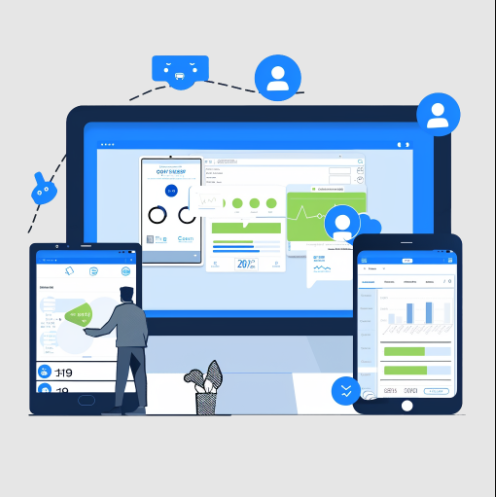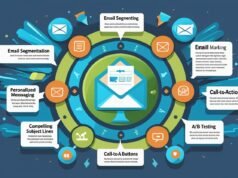In the rapidly evolving landscape of digital marketing, agencies and businesses constantly seek a competitive edge through optimized workflows and enhanced performance. The convergence of comprehensive CRM and marketing automation platforms with sophisticated ad monetization technologies offers a powerful synergy. This article explores into the technical details of integrating GoHighLevel, an all-in-one sales and marketing platform, with Uphex, an advanced ad optimization and monetization solution. We will explore the architectural considerations, data flows, and the technical mechanisms that enable this integration to drive superior ad performance and revenue generation.
GoHighLevel: The Core of Client Management and Marketing Automation
GoHighLevel (GHL) has emerged as a robust, white-labelable platform for agencies and businesses seeking to consolidate their digital marketing efforts. Beyond its user-friendly interface, GHL’s technical architecture is built for scalability and extensibility, making it an ideal hub for integrating third-party services.
From a technical standpoint, GHL provides a suite of functionalities crucial for ad management and client interaction:
- CRM & Lead Management: Stores comprehensive client and lead data, including custom fields essential for segmentation and personalized ad targeting.
- Marketing Automation Workflows: A powerful workflow builder allows for the creation of intricate automated sequences triggered by various events (e.g., lead capture, campaign status changes). These workflows are pivotal for orchestrating data exchange.
- Campaign Management: Facilitates the setup and management of various marketing campaigns, including landing pages, funnels, and email/SMS sequences that often accompany or follow ad clicks.
- Reporting & Dashboards: Offers customizable reporting capabilities, crucial for presenting ad performance metrics to clients.
- Open API and Webhooks: This is perhaps GHL’s most defining technical feature for integration. Its RESTful API provides programmatic access to nearly all platform entities—contacts, campaigns, opportunities, and more—enabling external systems to push and pull data. Webhooks offer real-time notifications for specific events, allowing immediate triggers in external applications.
- Custom Values and Fields: Enables the creation of unique data points within GHL, which can be populated by external systems like Uphex, providing a flexible data model.
Agencies leverage GHL for its ability to streamline operations, provide a unified client experience, and offer white-label solutions. Its extensible nature is key to enhancing its native capabilities with specialized tools.
Uphex: Precision Ad Optimization and Monetization
Uphex, in the context of this integration, is assumed to be an advanced platform focused on maximizing revenue from advertising campaigns. This typically involves sophisticated algorithms, real-time bidding, and in-depth performance analytics. Technically, it would embody:
- AI/ML-Driven Optimization: At its core, Uphex likely utilizes machine learning models to analyze vast datasets of ad performance, audience behavior, and market trends. These models automate bid adjustments, optimize targeting, and personalize ad creatives to achieve specific monetization goals (e.g., ROI, ROAS, eCPM).
- Real-time Data Processing: To be effective in ad tech, it must possess the capability to ingest and process massive volumes of impressions, clicks, conversions, and spend data in real time. This necessitates a robust, high-throughput data pipeline and specialized database architectures.
- Cross-Channel/Platform Integration: It would integrate with various ad networks (Google Ads, Facebook Ads, etc.), demand-side platforms (DSPs), and supply-side platforms (SSPs) to execute optimized campaigns and collect performance data.
- Bid Management & Budget Allocation: Automated intelligent bidding strategies based on predicted performance are central. This involves dynamic adjustment of bids and budgets across campaigns, ad sets, and even keywords or placements.
- Audience Segmentation & Lookalike Modeling: Leveraging first-party and third-party data to identify high-value audience segments for more precise targeting and expansion.
- Robust Reporting & Analytics API: Providing detailed performance metrics and insights through an accessible API, allowing integrated systems to pull granular data for analysis and reporting.
Uphex’s primary technical value lies in its ability to translate complex ad data into actionable, automated optimization strategies that drive higher ad revenue or better cost efficiencies.
The Integration: Technical Architecture and Workflow
The integration of GoHighLevel and Uphex represents a powerful symbiosis: GHL manages the client-facing aspects, sales funnels, and lead nurturing, while Uphex provides the deep-level ad optimization engine. The technical interplay between these two platforms is critical for seamless operation and maximum impact.
Why Integrate? The Synergies
The core motivation for this integration is to bridge the gap between lead generation/client management and ad campaign performance.
- Automated Feedback Loop: Uphex’s optimization insights can directly inform GHL’s automation workflows, and GHL’s lead conversion data can refine its targeting.
- Unified Reporting: Presenting a holistic view of marketing and ad performance to clients directly within GHL, powered by Uphex’s granular data.
- Scalability: Agencies can manage a higher volume of ad accounts more efficiently by automating optimization and reporting processes.
- Enhanced ROI: Ensuring ad spend is continually optimized by Uphex, while GHL maximizes the value of each generated lead.
Data Flow and Synchronization
The integration relies heavily on bidirectional data flow, primarily facilitated by RESTful APIs and webhooks.
1. GHL to Uphex (Campaign Setup & Contextual Data):
- Purpose: To provide Uphex with essential campaign parameters, client context, and conversion events for accurate optimization.
- Mechanism:
- GHL API Calls (Push/Poll): When a new client or campaign is set up in GHL, an automation workflow can trigger an API call to Uphex. This call would transmit vital information such as:
- Client ID and Account ID.
- Campaign name and objectives.
- Initial budget allocations.
- Tracking parameters (e.g., UTMs generated by GHL).
- Custom fields indicating specific client requirements or ad network preferences.
- GHL Webhooks: For real-time updates, GHL webhooks can be configured. For instance, when a “Lead Won” opportunity status is updated in GHL, a webhook can send this conversion event (along with associated ad click IDs if available) to Uphex. This allows Uphex to perform post-conversion optimization and accurate ROI attribution.
- GHL API Calls (Push/Poll): When a new client or campaign is set up in GHL, an automation workflow can trigger an API call to Uphex. This call would transmit vital information such as:
2. Uphex to GHL (Performance Metrics & Optimization Insights):
- Purpose: To ingest real-time ad performance data, optimization recommendations, and potentially automated adjustments into GHL for reporting, workflow triggers, and client communication.
- Mechanism:
- Uphex API Calls (Push/Poll): Uphex’s API is crucial here. Depending on the desired latency and data volume, GHL can poll Uphex’s API at regular intervals (e.g., hourly, daily) or Uphex can push data to specific GHL endpoints. This data includes:
- Impressions, Clicks, CTR, CPC.
- Conversions (if tracked by Uphex directly).
- Ad Spend, Revenue, ROAS/ROI.
- Optimization scores, bid recommendations, or even the actual new bid values.
- Ad Creative performance data.
- Custom Fields in GHL: Uphex data can be mapped directly to custom fields within GHL’s contact, opportunity, or campaign records. For example, a “Last 24hr ROAS” or “Uphex Optimization Score” field can be populated.
- Custom Objects (if available/simulated): For highly structured data (e.g., daily ad group performance), a custom object approach within GHL (or simulating one via linked custom fields across records) would be ideal.
- Uphex API Calls (Push/Poll): Uphex’s API is crucial here. Depending on the desired latency and data volume, GHL can poll Uphex’s API at regular intervals (e.g., hourly, daily) or Uphex can push data to specific GHL endpoints. This data includes:
Key Integration Points and Technical Implementation
- API-to-API Communication:
- Authentication: Both platforms require secure API authentication (e.g., API keys, OAuth 2.0 tokens). Implementing a secure token exchange and refresh mechanism is critical.
- Rate Limiting: Agencies must be mindful of API rate limits on both sides. Implementing exponential back-off strategies and robust error handling for 429 Too Many Requests responses is essential.
- Data Serialization: JSON is the standard for data exchange. Ensuring consistent data types and formats between the two systems is paramount to avoid parsing errors.
- Webhooks for Real-time Triggers:
- GHL’s webhook builder allows specifying a target URL (an endpoint on Uphex’s side or an intermediary function). This enables instant communication for events like a new lead capturing, a specific tag being applied, or an opportunity stage change. Uphex can then use this data to refine targeting or attribution.
- GHL Automation Workflows as Orchestrators:
- GHL’s workflows can be designed to:
- Initiate Uphex actions: When a client onboarding workflow is complete, trigger an API call to Uphex to set up initial campaign parameters.
- React to Uphex data: If Uphex pushes daily ROI figures to a GHL custom field, a workflow can be configured to:
- Send an internal notification if ROI drops below a threshold.
- Generate a detailed client report including the Uphex data.
- Even trigger an action back to Uphex (e.g., “pause ad set X”) if business rules dictate.
- GHL’s workflows can be designed to:
- Reporting and Dashboards:
- By populating GHL’s custom fields and leveraging its reporting module, agencies can build consolidated dashboards that display both GHL-specific metrics (e.g., lead volume, conversion rates through funnels) and Uphex-derived ad performance data (ROAS, ad spend, eCPM). This provides a single pane of glass for clients.
Technical Challenges and Considerations
While powerful, such an integration presents several technical challenges:
- Data Mapping and Transformation: Ensuring that data fields, identifiers, and values align perfectly between two disparate systems can be complex. ETL (Extract, Transform, Load) processes may be required, potentially using an intermediary layer (e.g., a serverless function, an iPaaS like Zapier for simpler cases, or custom middleware for complex needs).
- Error Handling and Logging: Robust mechanisms for identifying, logging, and gracefully handling API errors (e.g., invalid data, authentication failures, rate limits) are crucial to prevent data inconsistencies or service interruptions.
- Scalability and Performance: As the number of clients and ad campaigns grows, the volume of data exchanged can become substantial. The integration must be designed to scale, considering API limits, data processing capabilities, and potential performance bottlenecks.
- Security and Data Privacy (GDPR, CCPA): Transmitting sensitive client and performance data requires strict adherence to security best practices (HTTPS, secure API key management, data encryption) and privacy regulations.
- Latency: The “real-time” aspect of ad optimization means minimizing latency in data synchronization. While webhooks offer immediate triggers, polling strategies need to be optimized for acceptable delays.
- Versioning: Managing API version changes on either GHL or Uphex’s side requires a flexible integration design that can adapt to updates without breaking existing functionality.
Conclusion
The technical integration of GoHighLevel and Uphex for ad monetization unlocks a new dimension of efficiency and performance for digital marketing agencies. By programmatically connecting GHL’s comprehensive client management and automation capabilities with Uphex’s sophisticated ad optimization engine, businesses can achieve a continuous feedback loop that maximizes ad spend ROI and streamlines reporting. This deep dive into the “under the hood” mechanisms—from API communication and webhook triggers to data mapping and workflow orchestration—underscores the technical sophistication required to build and maintain such a powerful synergy. As digital advertising continues to evolve, robust, intelligent integrations like this will be key to unlocking scaled growth and delivering unparalleled value to clients.







